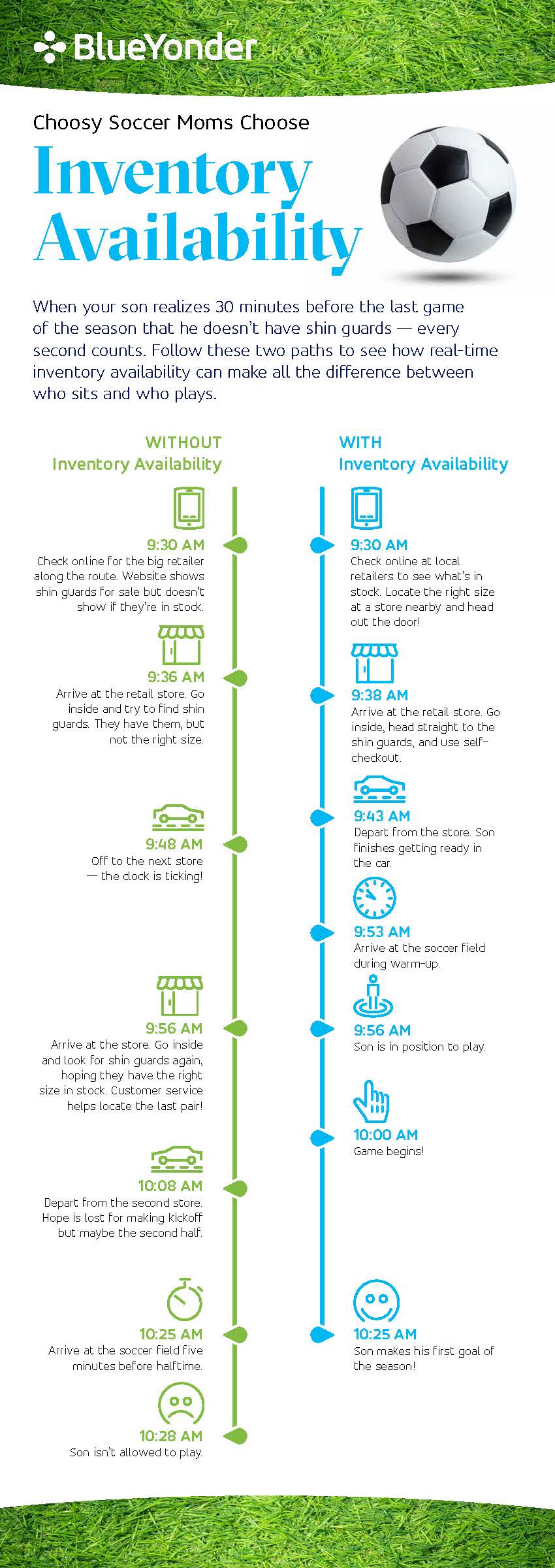As a retail product marketer here at Blue Yonder, I spend a lot of time talking about the skyrocketing popularity of omni-channel, the power of end-to-end visibility, and how customers have increasing demand for convenient and easy shopping experiences. But it wasn’t until a recent incident with my 12-year-old son, Jeremy, where I fully understood how commerce solutions that include AI and ML can actually help make people’s lives better.
Let me set the stage. It’s 9:30 a.m. on a Saturday, and it’s the last soccer game of the season. I’m drinking coffee and feeling good, since (for once!) I’m ahead of schedule. Just then, Jeremy tells me he can’t find his shin guards and must have them to play. “No problem,” I thought, still feeling confident. “The game doesn’t start until 11 a.m. We’ve got plenty of time to go to the sporting goods store across town, get new shin guards, and make it to the field.” Just then my husband called from work to remind me the game actually starts at 10 a.m. That happy, calm feeling was now gone.
There were only 30 minutes to get out the house, shop for shin guards and get to the field. Knowing we didn’t have a moment to spare — and how important it was to Jeremy to make the last game — I realized I had to know exactly where to find shin guards even before leaving the house. The sporting goods store I had in mind was 20 minutes away, in the wrong direction, so that was out. It was time to browse online for other local retailers along the route. The first retailer showed they sold soccer equipment but didn’t show what was in stock and what wasn’t. Nope, too risky.
I checked a different retailer’s website and saw three pairs of boys XL shin guards were in stock at the store near me. We jumped in the car and headed that way. We ran in the store, grabbed the shin guards, and were in and out in six minutes. Jeremy finished getting ready for the game along the way, and we got to the field — I am not making this up — at 9:53 a.m. Warmups were still going on, so Jeremy was able to play his last soccer match — and it was all thanks to inventory availability.
Later that day after the game, it hit me like a ton of bricks. People don’t shop thinking about technology or even channels, they shop based on what’s easiest for them in that moment of need. When I needed shin guards, I didn’t think about microservices, or what they enable. I only thought of Jeremy and how important it was to him to finish the season playing alongside his teammates.
But let’s talk about the innovations that made this experience a reality. The retailer had to know every item that was in stock across every location. Plus, inventory balances would need to update in real-time to give me the confidence shin guards would still be in-stock when I arrived. This requires understanding where inventory is located across channels and locations and for the retailer to have a singular view of this data.
Blue Yonder helps retailers achieve a holistic view of inventory availability at both the enterprise and local levels to deliver seamless customer experiences. Retailers can share this data with consumers at the beginning of their shopping journey to help guide their purchase decision. With geolocation, customers see what’s in stock at each location and whether it’s available for in-store shopping, curbside pickup or shipping. This not only gives customers peace of mind regarding their purchases, it helps drive incremental sales for retailers that can offer alternatives if a single store is out-of-stock. In my case, this visibility gave me the peace of mind that my local store had the shin guards Jeremy needed.
That Saturday, I was thankful for all the behind-the-scenes technology that made my shopping experience so positive. I realized how much of an impact inventory availability had over that tiny but important slice of my life that day, and how it was the one thing that made it possible to get Jeremy to his game on time — with shin guards! The experience got me thinking about what would have happened if I had to shop the old-fashioned way and take my chances at the store without inventory availability. How different would our day have turned out?
Check out the infographic below to see a side-by-side timeline of choosing a retailer with inventory availability — versus choosing one without.


